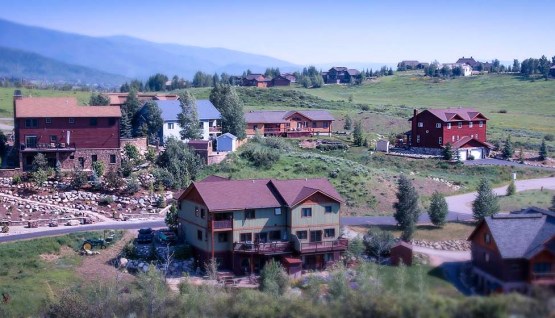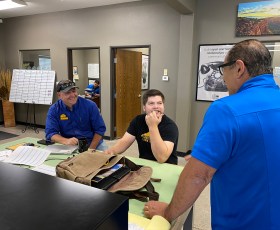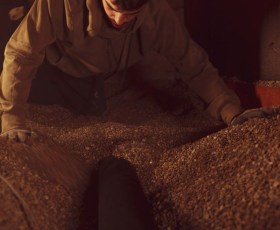Crawl Space Problem Signs
Foundation Repair of Western Colorado

Sagging Floors
Sagging floors are a fundamental problem sign for any property, no matter how slight the unevenness is. Here’s what you need to know about sagging flooring and how to fix it.
Foundation Repair of Western Colorado

Wood Rot
Wood rot is a common issue in damp and humid crawl spaces, but if you learn to identify it early, you could avoid many of the worst issues that are often connected to it.
Foundation Repair of Western Colorado

Crawl Space Mold
Mold forms in any moist environment. Unfortunately, this can include crawl spaces in Grand Junction, Colorado. In fact, mold is a problem sign of crawl space damage.
Foundation Repair of Western Colorado

Crawl Space Condensation
Crawl space condensation can damage the foundation of your home. Check out the problem signs that can warn you before it's too late.
High electric bills, poor air quality, and pests may be indicators that there’s something amiss in your crawl space. Crawl space vents tend to be the culprit, as it was commonly believed from the mid-20th century to the early 1990s that crawl space vents were needed to regulate the temperature in the space below your home. Now, we know that vents are the cause of crawl space issues, as it provides an opening for problem signs to sneak their way in.
Causes of Crawl Space Damage
Crawl space problems can weak havoc to the rest of your home, learn more about what causes your crawl space to become damaged.
Having a vapor barrier to properly seal your crawl space is essential. However, many crawl spaces completely lack a vapor barrier covering the walls and dirt floor, or a low-quality or damaged vapor barrier is in place. The minimum thickness requirement for vapor barrier installation is 6-mil. But this is very thin, can easily rip and sustain other damage, traps moisture, and may not fully cover the crawl space.
While building code has traditionally called for crawl spaces to be built with open vents, this is a harmful practice. Outside air, water, pests, and other nuisances can freely enter your crawl space through these vents. This can directly contribute to dampness, damage, and general unhealthiness in your property’s crawl space and throughout the rest of your home.
The stack effect is a term used to describe how air moves in and out of your home based on the temperature and moisture level. For many homeowners, the stack effect can affect the air quality of their home and cause their electricity bills to go up higher than usual.
More specifically, the stack effect is the process in which hot air escapes a home through the attic/upper floors. This process of air leaving the home creates a vacuum in the lower levels of the household, and new air is pulled upwards through the crawl space.
Award-Winning Service
-
Joe, Marc, and Tim did a great job and were very professional throughout the project. Thanks again, guys!
Foundation Repair of Western Colorado
View review Read Dan Hammon's review for Foundation Repair of Western Colorado
-
Chad and Chris were very professional. Chad kept me informed of their progress and consulted with me in a timely manner when changes to the original plan had to be made. I would definitely recommend FRWC for anyone needing their services.
Foundation Repair of Western Colorado
View review Read Richard Meck's review for Foundation Repair of Western Colorado
-
Chad, Dontez and Jay were wonderful. Chad was honest and communicated with me so I was up to date on what was going on. I was very impressed with their workmanship and professionalism. They were a great team to work with.
Foundation Repair of Western Colorado
View review Read Connie Nunley's review for Foundation Repair of Western Colorado
-
Dalton, Joseph B, and Jacob were great!
Foundation Repair of Western Colorado
View review Read Danny Tebbenkamp's review for Foundation Repair of Western Colorado
-
Dalton, Joseph B, and Jacob were very professional, respectful, and friendly. Dalton kept us informed with everything they planned to do and checked in with us throughout the process. They were open to questions, and called headquarters for us…
Foundation Repair of Western Colorado
View review Read Dani Long's review for Foundation Repair of Western Colorado
Crawl Space Solutions
You don’t have to live with the stress of a nasty crawl space and its effects. Take steps to protect your home and your family today by contacting Foundation Repair of Western Colorado. We provide products and services you can trust, backed by transferable warranties.
Foundation Repair of Western Colorado

Crawl Space Support Jacks
IntelliJack™ crawl space support posts provide an effective, durable solution for leveling and stabilizing damaged crawl spaces.
Foundation Repair of Western Colorado

Vent Covers
Our crawl space vent covers will prevent the elements and critters from disturbing your home.
Foundation Repair of Western Colorado

Crawl Space Vapor Barrier
A vapor barrier in a crawl space helps control moisture and protect against mold.
Foundation Repair of Western Colorado

Crawl Space Insulation
Crawl space insulation can make your whole house more comfortable, improve the air quality, and reduce your energy costs.
Is Crawl Space Repair and Encapsulation the Right Solution for Me?
Basements are the primary foundation type in many Colorado and Utah homes from Buena Vista to Moab. However, combination homes are also extremely common, meaning you have a basement space, but the rest of your foundation is made into a crawl space. This is typically done to neatly store the various ducts and piping needed to keep your home going. Though states like Colorado and Utah are accustomed to dryness, moisture can creep its way in through vents and collect in your crawl space.
This can set into motion a combination of problems that will affect your daily life including heightened allergies or asthma due to mold, pest infestations, bouncing or sagging floors, and higher energy bills.
Left to intensify, these issues will only grow worse with time and could have long-term effects on your health and safety. Setting up a free inspection with Foundation Repair of Western Colorado only takes a minute. Get started on fortifying your home today!
FAQs
Many people are reluctant to cover all their crawl space vents and access ports, because they do not want to lift flooring to allow access to their crawl space from inside their homes. There are certain covers that can open and close, however. Crawl space doors, as they are called, are becoming more common.
The Benefits
The most obvious benefit of choosing a crawl space door rather than a simple vent cover is that it can be opened and closed as needed. This ensures you have access to your crawl space from outside when needed, but that your crawl space is otherwise secure. This is achieved by ensuring that the door forms a water-tight seal.
This is very useful for those who have difficult-to-use internal access spots and homes in which the internal access points are smaller than the exterior crawl space vents or doors. Hypothetically, well-made crawl space doors impart the benefits of external access points or crawl space vents without the drawbacks and dangers of leaving the vents open.
The Issues
The main problem with crawl space doors, or vents that can be opened and closed, is that many homeowners forget to close them for days or even weeks at a time. This defeats the purpose and leads to the exact same issues in a crawl space as would have been present if the vents were not covered at all.
Likewise, these vents and doors have their own sets of issues to contend with. For example, these kinds of vents and covers need to form a proper seal in order to be effective. If they do not fit well, they become warped, or the sealant starts to crack and wear away, moisture and pests will be able to get into your home quite easily, causing dampness and damage in just the same way as open vents would. As such, it is important to be aware of the condition of your crawl space door.
If you’re going to choose new insulation for your crawl space, you need to go with something appropriate. There are different insulation materials to choose from, but not all of them work well for crawl spaces. The three most popular insulation materials used are fiberglass, cellulose, and foam. Each is made of a different insulation, and each has its own properties.
R-value is something you should consider when deciding on the material. The R-value indicates how well the material can insulate a space. The higher the R-value, the better the insulation material. Across Colorado, different R-values are required because of the varying climate across the state. Grand Junction, with its hot summers and short winters, needs an R-value of 25-30 for crawl spaces.
- Fiberglass and Cellulose
Fiberglass is one of the most common insulation materials used in the country. It’s made of plastic that’s been reinforced with small glass particles. It keeps the heat trapped in a space by absorbing it. The problem is that it not only absorbs heat, but it also absorbs moisture. Once it absorbs moisture, it keeps your crawl space humid and also begins to break apart as the moisture weighs it down.
Cellulose is better, but it still falls for all the same shortcomings as fiberglass. Part of it is made of paper, so it’s incredibly absorbent and retains water. Fiberglass has an R-value of 2.2 to 2.8 per inch and cellulose has 3.1 to 3.8. Neither of these materials has the necessary properties to fit your crawl space.
- Foam and Polystyrene
Polyurethane foam insulation is the superior insulation material in comparison to fiberglass and cellulose. It typically has an R-value of 6.3 per inch and is not absorbent. However, is it enough for a crawl space in Grand Junction? Turns out, there’s an even better option.
Polystyrene has the most potential of any of the previously mentioned materials. It has an R-value of 3.6 to 4, but it can increase if mixed with other materials. For example, our ExTremeBloc™ Crawl Space Insulation has a polystyrene core. It’s embedded with graphite particles that help reflect heat. Overall, it has an R-value of 11 per inch, making it the best insulation material for a crawl space.
We firmly recommend that you encapsulate your crawl space in order to protect your home from dampness and damage. We also recommend that you contact a professional to ensure a high-quality finish.
The Benefits of Waterproofing
Waterproofing your crawl space is incredibly important to maintaining its health and well-being. The benefits of waterproofing are many (when it’s done right). The most obvious is the reduction in humidity, dampness, and the likelihood of mold, mildew, and pest infestation. This means that a property with a waterproofed crawl space is healthier in a structural sense but also has a healthier environment for you and your family.
Furthermore, properties that are fully waterproofed are less likely to experience temperature fluctuations as a result of drafts and the stack effect. This means your HVAC system won’t have to work so hard if you waterproof and encapsulate your home. This will increase your property’s energy efficiency and lower your energy bills.
Seek Professional Help
Whatever you do, we do not recommend that you try to waterproof your crawl space alone. While DIY can present a tempting prospect for those looking to save money, we urge you to seek professional assistance. This is important because of the many different things that can go wrong when you try to waterproof or encapsulate on your own. The most obvious issue is making sure all underlying damage and problems have been dealt with. If you cannot recognize, diagnose, and repair structural or plumbing issues, you will simply cover them up.
Likewise, as an amateur, you will not have access to the best materials, tools, and products through local hardware stores. Professionals, by contrast, have the benefit of professional supply stores and being able to buy directly from the manufacturer. This means that they can get a better product, often for the same price. While professional services can seem a little expensive, they offer better value for money in the long term. As such, it is best to let a professional deal with your open vents.
If how high your energy bills are is tied to the health of your crawl space, is there anything you can do about it? Making sure that your crawl space is in inadequate condition is the first step to having a lower energy bill. You’ll have to consult a foundation repair expert to inspect the extent of the damage and see what your options are.
- Repairs
High energy bills and damaged crawl spaces go hand in hand. If you want to make sure no air can go in and out of your crawl space, you need to think about repairing it first. Cracks in the foundation can allow large quantities of moisture and air into space. If you had a basement, it would be easier to spot these cracks, but crawl spaces are so small, it can be difficult to move around in them for a proper inspection unless you’re a professional.
Repairing a crawl space involves clearing out all the mold growth from the wood and concrete. Any wood that has rotten beyond its limits should be replaced. Crawl space stabilizers can be installed to provide the floor with better support. If the damage is severe and there’s settling, helical piers can be installed to set the foundation right.
- Waterproofing
Once repairs are done, the real issue can be addressed. All crawl spaces should be waterproof in order to protect foundations from damage and protect homeowners from mold, high humidity, and high energy bills. When waterproofing a crawl space, the entire area can be encapsulated and closed off with the use of vapor barriers.
To make sure no humidity is left in the space, an industrial-grade dehumidifier can be installed. Then a sump pump can pump out any water that gets into the crawl space as well as the surrounding area when it rains. It’s especially effective if it’s connected to any outdoor drainage system.
We do not recommend that you waterproof your property alone for several reasons. Instead, you should contact a professional to ensure you get the right solution (and results) for your property and needs.
DIY Goes Wrong Too Often
The biggest problem with DIY waterproofing is that it is too hard for amateurs to accurately assess and diagnose underlying issues in their property’s crawl space. The signs of structural damage, for example, can be incredibly subtle if you do not know what you are looking for. If you simply waterproof without looking for or dealing with underlying damage, you could cover up the signs and allow it to grow and spread unchecked. This could be disastrous in the long run.
Worse still, you could trap moisture into your property and create a kind of incubator for mold and mildew. This will lead to bad smells in your home but also create an unhealthy environment for you.
Professionals Have the Skills
When you hire a professional, you will get the right solution for your home the first time around. As well as being able to identify underlying problems and damage before waterproofing, they will be able to react to any unexpected issues that arrive efficiently and effectively. Furthermore, they have the skills and training to use the waterproofing tools and products on the market to provide you with the best possible results.
They are less likely to make mistakes, or cause damage to the products (or your home). This is because they can buy from professional supply stores and direct from product manufacturers when needed. Beyond all else, professionals have the experience to work effectively in the cramped conditions that a crawl space provides. This is no mere feat, considering the average crawl space is three to five feet in height on average. When you have concerns about your crawl space, contact the expert!
There could be a number of reasons that your crawl space is flooded or taking on substantial amounts of water, but the causes can be generally broken up into internal and external. No matter the source of the water in your home, it will cause damage if left unattended.
Internal Sources
The main internal sources of water are your plumbing system and attached appliances. Weakness in the joins between pipes, corrosion, excessively high-water pressure, blockages and appliance malfunction or breakdown can all cause leaks and flooding inside your home. This water will pool at the lowest level of your home, such as around your sump pump.
Internal plumbing floods and leaks are unfortunately common. While we’d all like to think that we can avoid them, the fact is that we are likely to have to deal with one at some point. Thankfully, plumbing and appliance leaks are generally easy to spot and fix. Plus, if you catch a leak quickly, you can generally avoid wider structural damage to your home.
External Sources
External causes of flooding and humidity tend to be harder to spot and are more likely to be connected to structural issues in your home. The most obvious and benign (relatively speaking) potential cause is the presence of open vents in your crawl space. These allow water to enter your property during periods of heavy rain, snowmelt, and localized flooding. There are other potential causes, however, that you should be aware of.
The most worrying possibility is that your home’s foundation or walls have been damaged in some way. Even relatively small cracks can allow a surprising amount of water into a property. Foundation damage is the most serious potential cause of flooding is foundation subsidence or settlement and will require specialist foundation repair services to prevent the recurrence of flooding during periods of wet weather and soil saturation.
Why Crawl Space Encapsulation is Needed

Enhances Your Home’s Energy Efficiency
Freezing cold weather and even snowstorms can bring icy temperatures into the lower area of your home. When this happens, you may notice your energy bills hiking, as your HVAC unit works harder to offset the frigid temperatures. When you encapsulate your crawl space, you seal off all major entry points where outdoor temperatures can evade.

Fortifies Your Home’s Supports
Issues deep in the crawl space can make their way to your support joists or beams, weakening them. When this happens, you may notice spots on your floor that are more fragile than others, being particularly bouncy or saggy. This can be a result of dry rot or even crumbling, wet supports. Using crawl space support jacks, you can feel the safety of a stronger foundation and a more level floor.

Improves Air Quality
Due to the stack effect, the moldy, stale, or pest-infested air festering in your crawl space will rise into your home and affect your living space. Mold spores or smells and toxins from pest droppings may bother those in your home with allergies or asthma. Encapsulation makes your crawl space a less inviting place for mold to form and for pests to gather.
Crawl Space Repair & Encapsulation Tips & Mistakes
Mistakes to Avoid
- Repeatedly Calling Pest Control
While it’s true that pest control can get rid of the insects in your crawl space, they don’t deal with sealing your crawl space from the outdoor elements that attract pests. The most common crawl space pests are rats, mice, cockroaches, termites, carpenter ants, and even stray animals. After you have an exterminator rid your crawl space of pests once, you’ll want to have crawl space experts completely seal it off with a 20-mil thick vapor barrier, dehumidifier, crawl space vent covers, and more.
- Doing DIY Crawl Space Repair
Many homeowners understandably try to fix their crawl space problems on their own using one or two store-bought solutions like flammable spray foam or dehumidifiers. These at-home solutions may have a backward effect on your crawl space, as spray foam tends to lock in moisture, helping mold accelerate underneath it. Installing a dehumidifier by itself may also not be safe; if you leave your crawl space vents unsealed, it may end up breaking from a flood or by pest interference. Encapsulation is a multi-faceted solution of services and products that all work together to create a clean, dry crawl space. Experts don’t recommend picking and choosing just a few.
- Ignoring Other Foundation Issues in Your Home
Since many crawl space, basement, and foundation issues grow from the same root causes, if you’re seeing problems in one area, you may see them in other areas as well. If you’re seeing wall cracks in your basement, or even drywall in your upstairs living area, all these issues are likely connected.
Helpful Tips
- Hire A Specialty Crawl Space and Foundation Company
It can be daunting to hire a contractor, but the best thing you can do is your homework. Research repair companies that can help you, and make sure you learn as much as you can about a company. Check out reviews and third-party resources like the Better Business Bureau and ask for references. Don’t forget to inquire about contractor essentials like licensing, insurance, certificates, warranties, written estimates and contracts, and other important documents. You’ll be bringing these people into your home, so you need to feel comfortable with them and confident in their abilities.
- Have Regular Inspections Done To Your Home
Our certified field inspectors will complete a free thorough assessment of your crawl space and other issues, and then discuss our findings with you as well as your goals with a repair project. Then, the inspector will be able to put together an estimate that includes a plan for repair with solutions customized to meet your specific repair needs. We’ll also consider your budget and go over financing options. Take your time to review this estimate and don’t hesitate to follow up with your inspector with any questions or concerns.
- Encapsulation Improves Your Home’s Market Value
Whether you intend to be a lifelong owner of your home or you’re thinking about selling soon, your house is going to be on the market at some point. Is it ready and has it retained its value? A lot can affect your home’s value and resale value, including the condition of the crawl space. Why not save yourself a lot of time and headaches and get it repaired now? You could sell as-is, but you’ll still have to fill out the Seller’s Property Disclosure form. With this form, you’ll have to disclose any known past or current problems like moisture and water, flooding, cracks, settling, termite presence and damage, and more. Plus, things like foundation issues can reduce your home’s resale value by 10 to 30 percent, and homebuyers could have problems getting a mortgage. Most homebuyers expect a home to be free of problems, and a safe and healthy house is much more attractive to potential owners as opposed to one with mold and uneven floors.
Find your service area

Aspen, Colorado
Known as one of the most famous ski towns in the world, Aspen, CO sees its fair share of foundation, basement, and crawl space damage due to spring thaws and winter freezes.

Clifton
If your Clifton, CO home is experiencing issues with foundation slab cracking, basement, or crawl space water damage, or failing wall supports, contact our team at FRWC.

Durango
With Durango’s soil being primarily clay, this can cause a multitude of issues with your home’s foundation and basement because of its poor drainage capabilities.

Edwards
Located just 15 miles away from Vail, Edwards, CO, is a sleepy ski town nestled in the heart of the mountains. Unfortunately, the winter season brings its fair share of damage to homeowners' basements and foundations.

Fruita
Within the Grand Valley, Fruita, CO homeowners see their fair share of foundation, basement, crawl space, and concrete damage around their homes.

Glenwood Springs
Known for their natural hot springs, Glenwood Springs, CO is no stranger to the damaging effects water can have on foundations, basements, and concrete structures.

Grand Junction, Colorado
For Grand Junction, CO, homes both big and small, old and new, foundation and basement damage can be both easy to miss and expensive to fix.

Montrose
Are you looking to buy a home in Montrose, CO? Identifying foundation issues is an important part of selecting a new home to ensure you make a sound investment, while protecting it for the future.

Steamboat Springs
The mix of sand and clay soils in Steamboat Springs, CO can make for a variety of water drainage issues for your foundation and basement.






